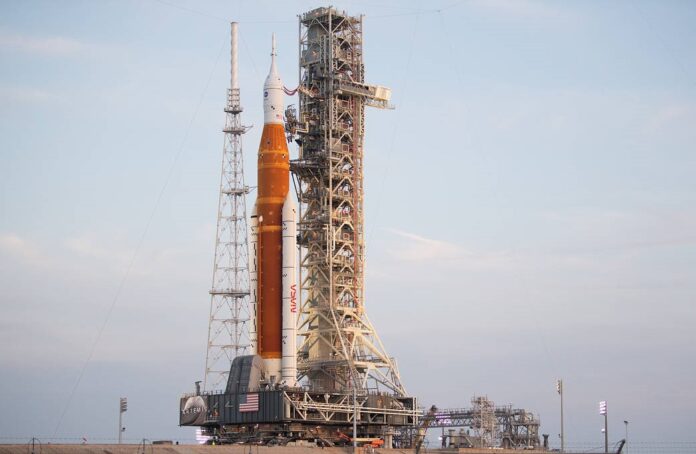After battling fueling issues Saturday, Artemis I did not launch for the first leg of its historical journey, disappointing diversified spectators, including UCF fans.
The Artemis I stack, which includes the Space Launch System rocket and Orion spacecraft, stood on Launchpad 39B at Kennedy Space Center in Cape Canaveral, facing new leak problems on its second launch attempt.
Before 5 a.m. Saturday, after mission managers received a brief on the weather, the team detected a liquid hydrogen leak in the disconnect cavity that feeds the rocket’s engine, NASA officials said in a press conference on Saturday. This led them to a decision to scrub the highly-anticipated launch for a second time.
Some space fans were disappointed but understanding. Working on the Artemis I project are several UCF students and staff members who weighed in on the risk of spaceflight.
“I am definitely disappointed that it did not happen when we were hoping to, but all the official sources are saying, ‘safety first’,” said Shivani Persaud, a UCF graduate student who is an Internal Engagement Specialist at NASA and works directly with the Artemis I project. “Instead of being disappointed and sad, I am grateful we didn’t take the chance to send up the rocket with such a big problem that could be lethal.”
Persaud said NASA’s Challenger – a 1986 rocket that exploded shortly after liftoff, killing seven astronauts in front of millions – is such a dark part of America’s history that nobody wants to see it ever happening again.
Senior biology major, Arya Patel was one of the UCF students who drove to Merritt Island on Florida’s Space Coast to watch the launch of the powerful rocket closely, expecting to be part of the historical moment.
“So frustrating,” Patel said. “I drove for more than one hour to be there. I arrived five hours before the launch, parked my car on the side of the road and stayed there until almost noon when they released the news saying Artemis I wouldn’t launch.”
Patel said she left the island disappointed with NASA’s decision because she did not know if next time, she will be able to attend the event.
With the decision to scrub, Artemis Mission Manager Mike Serafin said, the launch is practically postponed until October. This is due to other launches that are about to happen during the remaining September launch windows.
“This is an incredible hard business,” Serafin said at the press conference. “This is an initial test flight, as it was said by the administrator Nelson, ‘we’re gonna fly when we are ready’. As part of this initial test, we’re learning the vehicle, we are learning how to operate the vehicle and we are learning all of the things required to get us ready to fly.”
Serafin said that after trying different maneuvers to stop the leak, but unsuccessfully, the team decided to declare the scrub at 11:17 a.m. ET and started the procedures to put the vehicle onto safely mode.
NASA officials are concerned with the launch windows available for the year but have expressed along this journey that safety is one of the top priorities of this program and will take the necessary time to assure those problems are solved.
Carefully analyzing each issue, Jim Free, Associate Administrator for Exploration Systems Development, said the Artemis I team faced similar problems in both scrubs but in different proportions.
“We don’t go in these tests lightly,” Free said at the press conference. “We don’t just say, ‘Hey, we hope this is going to work.’ The confidence to make another launch attempt today was born out of the fact that we understood the hydrogen leaks we had on Monday.”
With an issue different from the previous one, Serafin said that it started when the team went from the slow to the fast fill of hydrogen. He said that even after the team tried to resolve the leak three times, the issue persisted in each test in a significant magnitude.
With the second scrub, worldwide fans showed dissatisfaction with the launch failure. Bruno Ávila, CEO of Space Today, came from Brazil just to see the Artemis I launch.
Ávila hosts a YouTube channel for Space Today where he posts space content in Portuguese for those who love technology and science but do not understand NASA’s English-only delivery. He traveled to Florida exclusively to stream the launch.
“Sadly, I did not see the launch,” Ávila said. “I don’t know if I can make it next time, but it was essential to be here and cover such a historical moment for all our followers. Connecting Brazilians with this spatial world is rewarding, and we were here for them, for those who do not understand English.”
At the press conference on Saturday, NASA Administrator Bill Nelson said that everybody is interested in space, and particularly this mission because it is not only going to the moon, but because it is a step closer to Mars. However, he said that though NASA tries to align public expectations with reality, people were still ready and looking forward to the launch. But a chance to fail the mission wasn’t an option.
“A cost of two scrubs,” Nelson said, “…is a lot less than a failure.”
With a no-go mission on Sept. 3, NASA minimized its launch window opportunities for September. According to the Artemis I Mission Availability calendar, there are still eight launch opportunities in October, one in November and only two in December.




